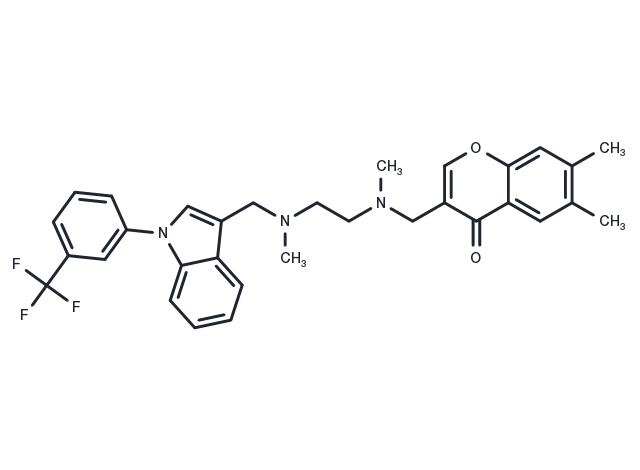Powder: -20°C for 3 years | In solvent: -80°C for 1 year


SPD304 is a selective TNF-α inhibitor and blocks the interaction of TNF and its receptor. SPD304 has an IC50 of 22 µM for inhibiting in vitro TNF receptor 1 binding to TNF-α.

| Pack Size | Availability | Price/USD | Quantity |
|---|---|---|---|
| 500 μg | 35 days | $ 75.00 | |
| 1 mg | 35 days | $ 140.00 | |
| 5 mg | 35 days | $ 563.00 | |
| 10 mg | 35 days | $ 980.00 |

| Description | SPD304 is a selective TNF-α inhibitor and blocks the interaction of TNF and its receptor. SPD304 has an IC50 of 22 µM for inhibiting in vitro TNF receptor 1 binding to TNF-α. |
| Targets&IC50 | TNF-α:22 μM |
| In vitro | SPD304 (2 μM) obviously rescues the survivability of aHSCs, reduces the production of lipid hydroxides, and increased intracellular GSH. The co-treatment of GA (75 μM) and SPD304 (2 μM), down-regulate TRADD almost 2-fold and p−RIP3 1.4−fold compared to GA alone and promotes caspase 8 activation [4]. |
| Molecular Weight | 547.61 |
| Formula | C32H32F3N3O2 |
| CAS No. | 869998-49-2 |
Powder: -20°C for 3 years | In solvent: -80°C for 1 year
DMSO: 24 mg/mL (43.83 mM), Sonication is recommended.
H2O: 18 mg/mL (32.87 mM), Sonication is recommended.
You can also refer to dose conversion for different animals. More
bottom
Please see Inhibitor Handling Instructions for more frequently ask questions. Topics include: how to prepare stock solutions, how to store products, and cautions on cell-based assays & animal experiments, etc.
SPD304 869998-49-2 Apoptosis TNF TNF Receptor Tumor Necrosis Factor Receptor inhibit Inhibitor SPD 304 TNFR SPD-304 inhibitor
